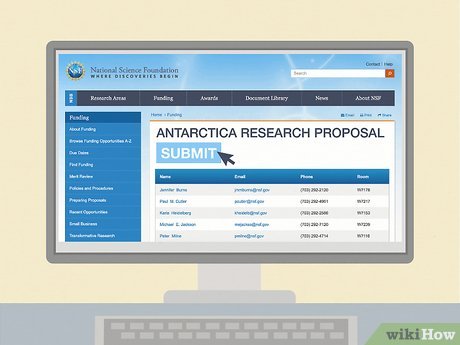Antarctica is one of the last true wildernesses on planet Earth. If you’re interested in experiencing the frozen majesty of the world’s southernmost continent for yourself, you have a couple of options available to you. Some travel companies offer guided expeditions to private citizens, though be warned—these kinds of trips aren’t cheap. If you have special scientific, academic, industrial, or military qualifications, you may also be eligible for assignment to an Antarctic outpost in a professional capacity.
StepsMethod 1Method 1 of 2:Embarking on a Private Expedition
1Look at travel agencies offering private expeditions to Antarctica by sea. Run a search for “private Antarctica expeditions” or something similar to pull up a list of participating companies. There are many to choose from, so take the time to compare a few in-depth before making a decision. Try to find a package that fits with your budget, time frame, and personal preferences.XThe company Wilderness Travel, for example, hosts a 20-day expedition that traces the historical steps of famed Antarctic explorer Sir Ernest Shackleton.XIf you’re looking for something a little less daring, a number of newer companies arrange luxury camping trips in Antarctica, some of which are as short as 24 hours.Private expeditions, which are designed to be educational as well as fun, are also sometimes advertised as “adventure cruises.”
2Start saving for your trip as early as possible. If you haven’t done so already, begin setting aside a little money each week or month to establish a travel fund. The average price of a private cruise to the 7th continent is somewhere between $7,000 and $10,000 USD per person, with some packages costing upwards of $50,000. That’s a lot of overtime!XConsider opening a separate bank account specifically for your travel savings. That way, the money you put in will remain untouched until you decide to use it.XFood is ordinarily factored into the ticket prices of most private expeditions, so at least you won’t have to budget separately for meals.
3Choose an expedition with activities that line up with your interests. While comparing different travel packages, keep an eye out for one that includes opportunities to enjoy your favorite activities. Depending on the package you go with, you might have an opportunity to go cross-country skiing, hike glacial mountains, camp out under the stars, head out on a sea kayaking voyage, or even try stand-up paddleboarding in below-freezing waters!XOther Antarctic pastimes that are popular with travelers include diving, wildlife sightseeing, penguin walks, Zodiac boat rides, and guided photography.Most ships have areas where passengers can rent or check out equipment, but it may be necessary to provide your own gear for certain activities like camping and mountaineering.
4Pack appropriately for the climate. Antarctica is one of the coldest places on the globe all year-round. For this reason, it’s crucial that you bring enough clothing to piece together several outfits that each consist of multiple layers. At the very least, you’ll need a moisture-wicking thermal base layer, a heat-trapping mid layer, and a fully waterproof outer layer. Warm gloves, rugged, waterproof boots, and insulated headgear are also a must.XIn addition to your main clothing items, it’s a good idea to leave some room in your luggage for accessories like extra socks (and lots of them), a cozy neck gaiter, a wind-resistant face mask, a pair of sunglasses, and a bottle of sunscreen.XBe sure to pack enough clothing to stay warm and comfortable for the duration of your trip. You won’t be able to buy anything once you arrive on the continent.
Tip: Don’t forget to bring along a camera to capture your experience. Even if you’re not a photography buff, you’ll undoubtedly want to look back on some of the incredible sights you’re bound to see along the way.

5Be aware of the potential dangers you’ll be facing. As thrilling as a polar adventure might seem, it’s not exactly a walk in the park. Antarctica is the single coldest, driest, windiest, and most remote place on the globe, which means that there are very real risks involved in traveling there. Think long and hard about whether you’re willing to accept these risks before you book your ticket.XThe United States government doesn’t provide support to members or private expeditions, except in rare emergency cases. This means that once you’re there, you’re on your own.National Science Foundation (NSF) officials operating in Antarctica recommend insurance to protect yourself against financial or material losses during your trip.XMethod 2Method 2 of 2:Participating in a Government-Supported Program
1Submit a research proposal for a chance to visit Antarctica as a scientist. Put together a detailed proposal outlining your scientific interest in Antarctica and submit it to the National Science Foundation (NSF). Officials will review the questions or theories raised by your proposal and determine whether it would serve as a solid basis for a scientific expedition.XMore specific information regarding the length, format, and content of your proposal, as well as the necessary eligibility requirements, can be found in the NSF’s Grant Proposal Guide.XMuch of the scientific research conducted in Antarctica is centered around fields like terrestrial and marine biology, glaciology, meteorology, astronomy, atmospheric physics, medicine, and earth and ocean sciences.X
Tip: The NSF awards roughly 50 research grants per year. If your first proposal doesn’t meet the institution’s standards for acceptance, try again the following year.

2Put in your bid for a spot as a scientist’s assistant if you’re still in school. Students aren’t typically considered for full-fledged research positions. However, if you have a professor, instructor, mentor, or employer who’s been awarded a grant, it may be possible for you to join them as an assistant. Talk to your superior about the possibility of appointing you to their field research team.XBe prepared to make a case for yourself as to why you would make a good research assistant. Perhaps you’re currently writing a thesis or dissertation related to some feature of the region, or your grades are among the highest in the class.Grant-winners are often encouraged to include qualified younger members (high school-age or older) on their teams, so your chances of being selected are as good as anyone’s.
3Apply for a field support position if you’re a tradesman with special training. As you might imagine, the success of an Antarctic expedition depends upon a network of skilled laborers, including construction workers, machinists, pilots, vehicle repair specialists, station and lab operators. If you think you might be a good fit for one of these jobs, contact the Leidos Antarctic Support Contract to sit for an initial interview and receive instructions for submitting your credentials.XIn addition to providing your work history and proof of citizenship, you’ll be asked to undergo a rigorous background check and drug screening, along with physical, dental, and psychological exams.Most Leidos contracts are for the austral summer season (October through February) or Antarctic winter (February through October).Keep in mind that if you manage to land a position, you’ll be living and working at your assigned station for the entire length of your contract.
4Volunteer for duty as a member of the military. If you’re an active member of the Air National Guard or Coast Guard, get in touch with an Air Force recruiter or the Washington division of the Coast Guard to request special deployment. Both of these groups run escort and support missions in Antarctica. This can be a good way to see the frozen landscapes of the world’s southern edge while also serving your country.XNavy ships also make regular through-trips to Antarctica and surrounding areas to deliver much-needed supplies.XReserve personnel for each of these organizations may also qualify for service.
5Serve as a public information representative if you work in the media. As part of their Antarctic program, the National Science Foundation works closely with various TV, radio, and print-based news outlets. If you’re a member of the press and want a chance to apply your talents in an exciting new environment, call the NSF’s Media and Public Information Section at 703-292-8070 for information on the selection process.XYou can also email the NSF’s Polar Outreach Program Manager directly at [email protected] assignments take place during both major field seasons. The deadline to apply is usually several months before the start of austral summer.








